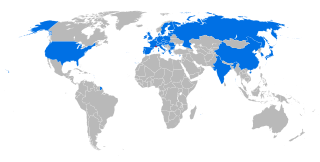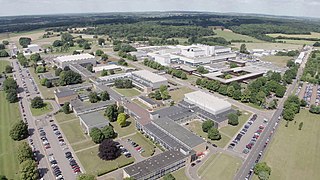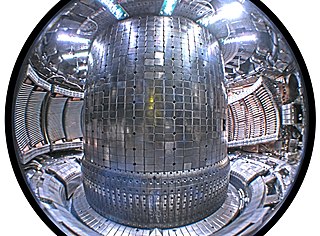Related Research Articles

A tokamak is a device which uses a powerful magnetic field to confine plasma in the shape of a torus. The tokamak is one of several types of magnetic confinement devices being developed to produce controlled thermonuclear fusion power. As of 2016, it was the leading candidate for a practical fusion reactor. The word "tokamak" is derived from a Russian acronym meaning "toroidal chamber with magnetic coils".

Fusion power is a proposed form of power generation that would generate electricity by using heat from nuclear fusion reactions. In a fusion process, two lighter atomic nuclei combine to form a heavier nucleus, while releasing energy. Devices designed to harness this energy are known as fusion reactors. Research into fusion reactors began in the 1940s, but as of 2023, no device has reached net power.
This timeline of nuclear fusion is an incomplete chronological summary of significant events in the study and use of nuclear fusion.

The Joint European Torus, or JET, is an operational magnetically confined plasma physics experiment, located at Culham Centre for Fusion Energy in Oxfordshire, UK. Based on a tokamak design, the fusion research facility is a joint European project with a main purpose of opening the way to future nuclear fusion grid energy. At the time of its design JET was larger than any comparable machine.

ITER is an international nuclear fusion research and engineering megaproject aimed at creating energy through a fusion process similar to that of the Sun. Upon completion of construction of the main reactor and first plasma, planned for late 2025, it will be the world's largest magnetic confinement plasma physics experiment and the largest experimental tokamak nuclear fusion reactor. It is being built next to the Cadarache facility in southern France. ITER will be the largest of more than 100 fusion reactors built since the 1950s, with ten times the plasma volume of any other tokamak operating today.
The Max Planck Institute for Plasma Physics is a physics institute investigating the physical foundations of a fusion power plant. The IPP is an institute of the Max Planck Society, part of the European Atomic Energy Community, and an associated member of the Helmholtz Association.

The T-15 is a Russian nuclear fusion research reactor located at the Kurchatov Institute, which is based on the (Soviet-invented) tokamak design. It was the first industrial prototype fusion reactor to use superconducting magnets to control the plasma. These enormous superconducting magnets confined the plasma the reactor produced, but failed to sustain it for more than just a few seconds. Despite not being immediately applicable, this new technological advancement proved to the USSR that they were on the right path. In the original shape, a toroidal chamber design, it had a major radius of 2.43 m and minor radius 0.7 m.

Cadarache is the largest technological research and development centre for energy in Europe. It includes the CEA research activities and ITER. CEA Cadarache is one of the 10 research centres of the French Commission of Atomic and Alternative Energies.

DEMO refers to a proposed class of nuclear fusion experimental reactors that are intended to demonstrate the net production of electric power from nuclear fusion. Most of the ITER partners have plans for their own DEMO-class reactors. With the possible exception of the EU and Japan, there are no plans for international collaboration as there was with ITER.

The Kurchatov Institute is Russia's leading research and development institution in the field of nuclear energy. It is named after Igor Kurchatov and is located at 1 Kurchatov Square, Moscow.

The KSTAR is a magnetic fusion device at the Korea Institute of Fusion Energy in Daejeon, South Korea. It is intended to study aspects of magnetic fusion energy that will be pertinent to the ITER fusion project as part of that country's contribution to the ITER effort. The project was approved in 1995, but construction was delayed by the East Asian financial crisis, which weakened the South Korean economy considerably; however, the project's construction phase was completed on September 14, 2007. The first plasma was achieved in June 2008.
EFDA has been followed by EUROfusion, which is a consortium of national fusion research institutes located in the European Union and Switzerland.
Ignitor is the Italian name for a planned tokamak device, developed by ENEA. As of 2022, the device has not been constructed.

Fusion for Energy(F4E) is a joint undertaking of the European Atomic Energy Community (Euratom) that is responsible for the EU's contribution to the International Thermonuclear Experimental Reactor (ITER), the world's largest scientific partnership aiming to demonstrate fusion as a viable and sustainable source of energy. The organisation is officially named European Joint Undertaking for ITER and the Development of Fusion Energy and was created under article 45 of the Treaty establishing the European Atomic Energy Community by the decision of the Council of the European Union on 27 March 2007 for a period of 35 years.
SST-1 is a plasma confinement experimental device in the Institute for Plasma Research (IPR), an autonomous research institute under Department of Atomic Energy, India. It belongs to a new generation of tokamaks with the major objective being steady state operation of an advanced configuration plasma. It has been designed as a medium-sized tokamak with superconducting magnets.

The Culham Centre for Fusion Energy (CCFE) is the UK's national laboratory for fusion research. It is located at the Culham Science Centre, near Culham, Oxfordshire, and is the site of the Joint European Torus (JET), Mega Ampere Spherical Tokamak (MAST) and the now closed Small Tight Aspect Ratio Tokamak (START).

In nuclear fusion power research, the plasma-facing material (PFM) is any material used to construct the plasma-facing components (PFC), those components exposed to the plasma within which nuclear fusion occurs, and particularly the material used for the lining the first wall or divertor region of the reactor vessel.
The ARC fusion reactor is a design for a compact fusion reactor developed by the Massachusetts Institute of Technology (MIT) Plasma Science and Fusion Center (PSFC). ARC aims to achieve an engineering breakeven of three. The key technical innovation is to use high-temperature superconducting magnets in place of ITER's low-temperature superconducting magnets. The proposed device would be about half the diameter of the ITER reactor and cheaper to build.
The tritium breeding blanket, is a key part of many proposed fusion reactor designs. It serves several purposes; primarily it is to produce further tritium fuel for the nuclear fusion reaction, which would otherwise be difficult to obtain in sufficient quantities, through the reaction of neutrons with lithium in the blanket. The blanket may also act as a cooling mechanism, absorbing the energy from the neutrons produced by the reaction between deuterium and tritium ("D-T"), and further serves as shielding, preventing the high-energy neutrons from escaping to the area outside the reactor and protecting the more radiation-susceptible portions, such as ohmic or superconducting magnets, from damage.
References
- ↑ The roadmap to magnetic confinement fusion, Damian Hampshire
- ↑ Beyond ITER. (PDF). 18 August 2008.
- ↑ Fusion Illusions. Michael Dittmar, Nuclear Monitor Issue: #698, Number:5997. 27 November 2009.